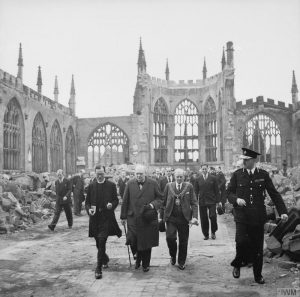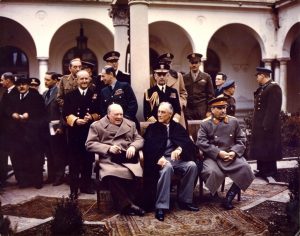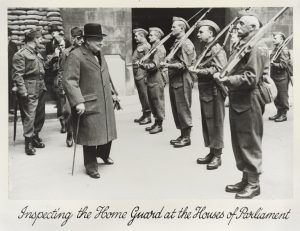
Finest Hour 188
A Difference Between Natures
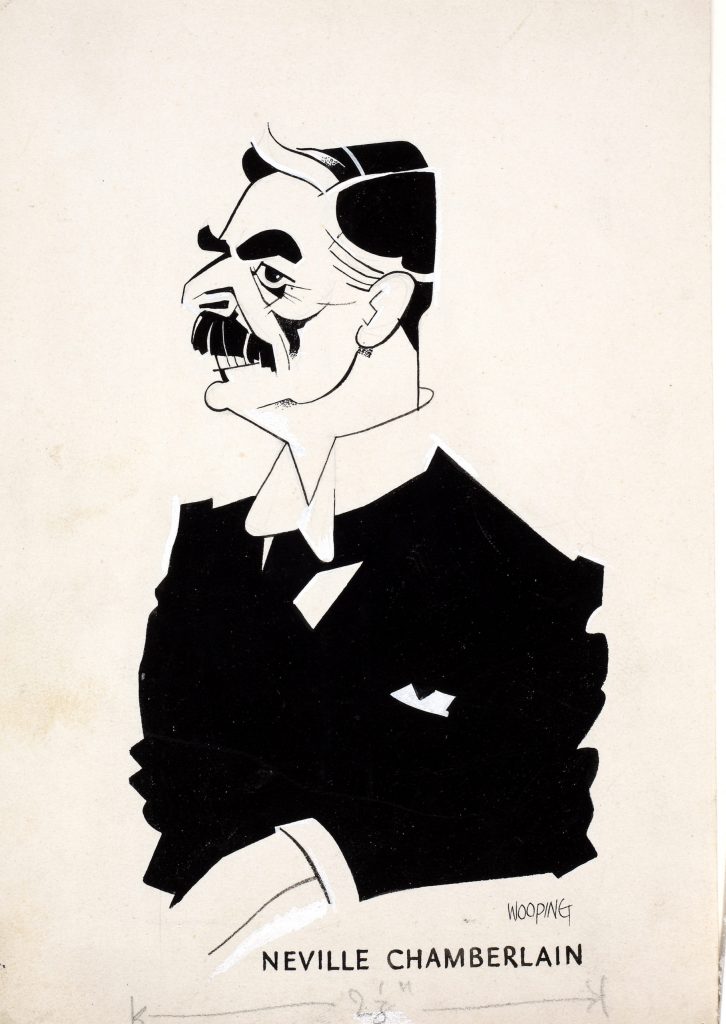
Caricature of Neville Chamberlain
January 2, 2021
Finest Hour 188, Second Quarter 2020
Page 28
By Stuart Ball
Stuart Ball is Emeritus Professor of Modern British History at the University of Leicester. His books include Portrait of a Party: The Conservative Party in Britain, 1918–1945 (Oxford, 2013).
Although very different in personality, the self-contained and often inflexible Neville Chamberlain and the emotional and often impulsive Winston Churchill had four things in common during their formative years.
First, both had fathers who were amongst the most dynamic and controversial figures in late-Victorian politics. Lord Randolph Churchill rose and fell meteorically in the Conservative Party of the 1880s, whilst the radical Liberal Joseph Chamberlain broke with his party over Home Rule for Ireland in 1886, joined a coalition government with the Conservatives in 1895, and then shattered that party’s unity by resigning from the cabinet in 1903 to advocate “tariff reform”—the campaign for protectionism that led Winston Churchill to cross the floor of the House of Commons and join the Liberal Party in 1904.
Second, neither was expected by his father to have a political career, but instead Churchill was to enter the army and Chamberlain to go into business; in both cases, they did not enter the House of Commons until several years after their fathers’ death.

2025 International Churchill Conference
Third, neither attended one of the old universities—Churchill went to the Royal Military College at Sandhurst and Chamberlain attended Mason College in his home city of Birmingham, studying metallurgy and engineering as a preparation for managing in the region’s manufacturing industries.
Finally, both spent a period in early adulthood in a remote part of the British empire: Churchill for two years as a junior officer on India’s north-west frontier, and Chamberlain in much greater isolation for six years in an unsuccessful attempt to grow sisal on an island in the Bahamas.
In other respects, they followed different paths during the two decades before the First World War. Churchill became an MP in 1900 and a cabinet minister in the Liberal government in 1908, after which he was always a prominent figure in national politics. Chamberlain was a successful Birmingham businessman and increasingly active in municipal affairs, becoming Lord Mayor in 1915–16. During the First World War he shared with Churchill the experience of a public failure which had lasting effects: for Churchill, this was the Gallipoli campaign and his period out of office in 1915–17, whilst in Chamberlain’s case it was his unhappy term as Director-General of National Service from December 1916 to August 1917, which led to his lifelong loathing of Lloyd George.
Despite his own setback, Chamberlain resolved to enter the House of Commons, and he became an MP in the 1918 general election at the age of forty-nine. He was an effective backbencher during the peacetime Lloyd George Coalition and then rose to the forefront with remarkable speed during the two years that Churchill was out of parliament, from November 1922 to October 1924. The fall of the coalition had sent most of the Conservative leaders into the wilderness and the new Prime Minister, Andrew Bonar Law, was in need of ministerial talent in the House of Commons. Chamberlain was first appointed Postmaster-General, then entered the cabinet as Minister of Health in March 1923, and became Chancellor of the Exchequer in August 1923 after Stanley Baldwin succeeded to the premiership. Chamberlain held this high office, however, for only five months until Conservative defeat in the December 1923 general election led to the installation of the first Labour government in January 1924.
Cabinet Colleagues
When the Conservatives returned to office following their landslide victory in the general election of October 1924, Baldwin offered Chamberlain the Treasury again. He preferred, however, to return to the less prestigious post of Minister of Health, for which he had already drawn up an ambitious programme of reforms—a decision that led to Baldwin’s surprise appointment of Churchill as Chancellor of the Exchequer instead. Chamberlain and Churchill were to provide much of the initiative and driving force of the 1924–29 government. They first collaborated on a comprehensive national insurance scheme, which was expanded to include pensions for widows and orphans. Chamberlain had planned this for 1926 but Churchill urged that by working together they could do so earlier, and it was announced in his first budget in April 1925.
The other major collaboration between Chamberlain and Churchill came during the second half of the government with the conjunction of Chamberlain’s plan to reform the Poor Law and Churchill’s proposal to reduce the burden of the rates (the local government tax) on industry and agriculture. Chamberlain considered Churchill’s scheme to be vague and impractical, whilst Churchill thought that Chamberlain’s more limited measure would undermine the case for wider reform. After considerable friction, a compromise was eventually reached and announced in Churchill’s fourth budget in April 1928. The experience led Chamberlain to conclude that whilst Churchill was “a brilliant wayward child,” there was “too deep a difference between our natures for me to feel at home with him.”1
Divergent Paths
After the Conservative defeat in the 1929 general election, the trajectories of the two men’s careers diverged for the next decade. The period in opposition during the second Labour government of 1929–31 confirmed Chamberlain’s position as the second figure in the Conservative Party and undisputed heir apparent to Baldwin. At the same time Churchill’s fortunes declined as he was uncomfortable with the party’s move towards protectionism, almost quitting the shadow cabinet on that issue in October 1930 before resigning over India in January 1931. When the National government was formed in the economic crisis of August 1931, Chamberlain was one of the four Conservatives in the emergency cabinet of ten. He returned briefly to the office of Minister of Health before becoming Chancellor of the Exchequer after the government’s massive election victory in October. Chamberlain held this office for five and a half years, during which he became an increasingly dominant figure in the government, and then at the age of sixty-eight smoothly succeeded Baldwin as Prime Minister and leader of the Conservative Party in May 1937.
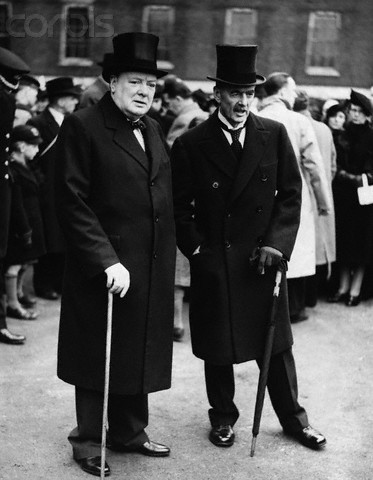
Whilst Chamberlain was at the centre of power, these were Churchill’s “wilderness years”; having left the leadership, he was not included in the National government, and during 1931–35 he focused most of his energy on an acrimonious opposition to its proposals for devolution in India. Churchill’s advocacy of greater spending on defence from 1932 onwards came more into Chamberlain’s sphere of responsibility, but from late 1933 he was also in favour of increased rearmament—and with the same priority on the air force—and their disagreement was not about the objective but rather the pace and what could be afforded.
Appeasement
How to respond to the expansionist ambitions of the German and Italian dictators was the crucial issue of Chamberlain’s peacetime premiership. He was convinced that his diplomacy of appeasement, combined with a rearmament programme that did not imperil the slow recovery from the Great Depression, was the only viable strategy. Chamberlain considered that those who advocated a more confrontational stance were unrealistic and dangerous and that their policy would be much more likely to lead to war with the thin-skinned and unpredictable dictators. For this reason, when he became Prime Minister he was resolved against including Churchill in his cabinet. This was partly because he believed Churchill would be a disruptive force, but even more because his appointment would send an aggressive signal that would undermine Chamberlain’s quest for a peaceful European settlement.
Despite Churchill’s criticisms of the Prime Minister’s policy towards Germany (though much less so of his appeasement of Italy), he still periodically hoped for the offer of a cabinet post, preferably in the area of defence and rearmament, such as the creation of a powerful Ministry of Supply. His hopes were raised after Hitler’s seizure of Bohemia in March 1939 damaged the credibility of appeasement and weakened Chamberlain’s position, but a meeting between the two in April did not result in any offer. In fact, at this time Chamberlain did seriously consider bringing Churchill into the Cabinet because his debating ability would strengthen the Government in the House of Commons, but this was outweighed by doubts whether he “would help or hinder in cabinet,” where he might “wear me out resisting rash suggestions.”2 Chamberlain’s comments in a letter to his sisters a year earlier are a succinct summary of his attitude during the whole period from 1924 to 1940: “I can’t help liking Winston although I think him nearly always wrong and impossible as a colleague.”3
First Lord of the Admiralty
In the summer of 1939 Chamberlain was irritated, rather than seriously concerned, by the pressure from some newspapers to include Churchill in the government. The eventual failure of appeasement with the declaration of war in September, however, combined with the refusal of the opposition Labour and Liberal parties to join the government, forced Chamberlain to broaden his administration in other ways. Even so, his position remained strong. He retained the support of most Conservative MPs, and he gave as little ground as possible— offering Churchill on 1 September responsibility for the navy as First Lord of the Admiralty and a place in the nine-member War Cabinet, and giving Anthony Eden a less important ministry outside it.
Thus Churchill returned to the office he had held at the outbreak of the First World War, in a position of both influence and some independence, as he was not associated with pre-war policies. He threw all of his energy into the post, but even though the navy was the one service actively engaged from the start of the war, it was not enough to absorb his attention and inventiveness. From his second day in office, Churchill began a stream of lengthy letters to the Prime Minister that ranged across the whole of the war effort. Although ostensibly sent “only in my desire to aid you in your responsibilities,”4 these intrusions understandably irrated Chamberlain, since he suspected these were partly intended for quotation in Churchill’s postwar memoirs. The issue came to a head on 2 October after receipt of a missive addressing three matters quite outside the remit of the Admiralty, all of which been discussed in recent War Cabinet meetings. This provoked Chamberlain to have a very frank talk with Churchill, who promised to write no more letters.
During the period of “phoney war” from September 1939 to April 1940, Churchill’s vigour and determination increased his public standing, whilst Chamberlain’s often lacklustre parliamentary performances and apparent complacency were eroding the confidence of Conservative MPs. The latter were not reassured by Chamberlain’s reshuffle of 3 April 1940, a modest affair in which a few unpopular ministers exchanged portfolios. It also included, however, the important development of making Churchill the chairman of the Military Co-ordination Committee, consisting of the other two service ministers and the three chiefs of staff, which made strategic proposals to the War Cabinet. Problems soon developed, though, because Churchill’s working hours and conduct of business exhausted and infuriated the other members of the committee. To alleviate the situation, and at Churchill’s suggestion, Chamberlain took the chair at the committee’s meetings from 16 April, as the attempt to counter the surprise German invasion of Norway reached its critical phase. Churchill returned to the problem of co-ordinating the defence services during a talk with Chamberlain on the evening of 24 April, when he proposed that he should become Minister of Defence with authority over all three services. Chamberlain, however, was against giving Churchill such extensive power because it would weaken the authority of the War Cabinet and restrict its ability to take decisions.
To the surprise of many, during Churchill’s service in Chamberlain’s government he adhered to a position of personal loyalty to the Prime Minister. This was most evident in the crucial debate of 7–8 May 1940 that followed the failure to prevent the German conquest of Norway, in which the closing speech was Churchill’s vigorous defence of the government. The sharp fall in its normal majority, however, forced Chamberlain to resign as Prime Minister. His preferred successor was Lord Halifax, partly because he would be more acceptable than Churchill not only to Conservative MPs but also to the Labour Party, whose entry into a reshaped government was now essential. At their crucial meeting on 9 May, Chamberlain attempted to secure this outcome by asking Churchill directly whether he would serve under Halifax; the ensuing silence led Halifax to withdraw his claim, and on the following day Churchill became Prime Minister.
Role Reversal
Chamberlain remained the leader of the Conservative Party and retained strong support amongst its MPs, as was visibly demonstrated by the lengthy cheers when he next entered the House of Commons on 13 May, whilst Churchill’s reception had been much cooler. Churchill recognised the importance of Chamberlain’s position, and, after being appointed Prime Minister, his first action was to write to thank his predecessor for his promise of support, frankly acknowledging that “to a vy large extent I am in yr hands.”5 Churchill’s next words, “& I feel no fear of that,” reflected not only reliance on Chamberlain’s sense of honour but also that since the outbreak of war the two had generally arrived at the same conclusion on important matters, such as the rejection of Hitler’s peace proposals after the conquest of Poland. They continued to do so, and in the War Cabinet discussion of 28 May Chamberlain gave decisive support to Churchill’s decision not to consider possible Italian mediation or any peace terms and to fight on even if France surrendered.
In contrast to the many inaccuracies and inventions of the recent film Darkest Hour and its distorted portrayal of Chamberlain, Churchill told his old mentor David Lloyd George: “I have received a very great deal of help from Chamberlain.”6 Far from intriguing against Churchill, Chamberlain was concerned about the effects on American opinion of Conservative MPs’ visible lack of enthusiasm for the new premier, and on his instructions the Chief Whip organised rousing cheers for Churchill in the House of Commons on 4 July.
As Lord President of the Council, Chamberlain’s co-ordination of domestic affairs enabled Churchill to concentrate on conducting the war; significantly, it was Chamberlain who chaired the War Cabinet when the Prime Minister was absent. Their productive partnership, however, was not to last; Chamberlain became seriously ill in July, and although after an operation he returned to
work briefly in early September, he was soon unable to continue. Now aware that his condition was terminal, he resigned from the government on 3 October and died on 9 November 1940, after which Churchill lamented to the Deputy Chief Whip: “What shall I do without poor Neville? I was relying on him to look after the Home Front for me.”7
Endnotes
1. Chamberlain to Lord Irwin, 12 August 1928, Stuart Ball, ed., Conservative Politics in National and Imperial Crisis: Letters from Britain to the Viceroy of India 1926–1931 (Farnham: Ashgate, 2014), p. 242.
2. Neville to Hilda Chamberlain, 15 April 1939, Robert Self, ed., The Neville Chamberlain Diary Letters, volume 4, The Downing Street Years 1933–1940 (Aldershot: Ashgate, 2005), p. 407.
3. Ibid., Neville to Hilda Chamberlain, 27 March 1938, p. 311.
4. Churchill to Chamberlain, 15 September 1939, Birmingham University Library, Neville Chamberlain MSS, NC/7/9/49.
5. Ibid., Churchill to Chamberlain, 10 May 1940, NC/7/9/80.
6. Churchill to Lloyd George, 29 May 1940, Parliamentary Archives, Lloyd George MSS, G/4/15/48.
7. James Stuart, Within the Fringe: An Autobiography (London: Bodley Head, 1967), p. 87.
Subscribe
WANT MORE?
Get the Churchill Bulletin delivered to your inbox once a month.

